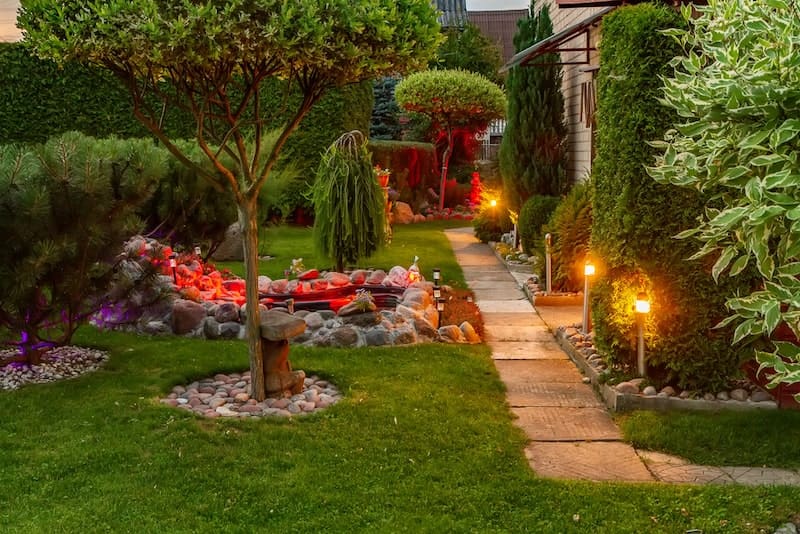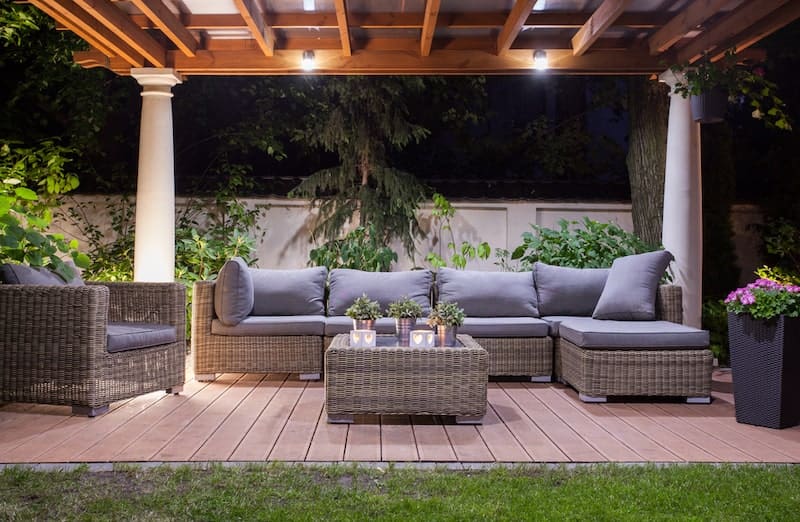Outdoor lighting serves aesthetic and functional purposes, enhancing the beauty of landscape and architectural features while providing safety and security. It can dramatically transform the ambiance of outdoor spaces after dusk, accentuating the elements and casting a warm and inviting glow.
In this guide, we’ll explore various outdoor lighting techniques for highlighting landscape and architectural features, helping you create a mesmerizing nighttime environment.
Uplighting
Uplighting is a popular technique for highlighting trees, plants, and architectural structures. It involves placing lights at ground level, aiming them upwards towards the featured elements. This effect creates a dramatic play of light and shadows, adding depth and dimension to the landscape.
Downlighting
The opposite of uplighting, downlighting involves placing lights above the featured elements, directing light downwards. This technique is ideal for illuminating pathways, entryways, and architectural details such as columns or pillars.
Silhouetting
Silhouetting is a creative outdoor lighting technique that creates a dramatic effect by backlighting objects against a dark background. Place lights behind trees or sculptures to create a striking silhouette effect.
Moonlighting
Moonlighting is a technique that mimics the soft, diffused light of the moon. This effect is achieved by placing lights high in trees and aiming them downwards through branches and leaves. It creates a dreamy natural appearance, perfect for highlighting garden paths or seating areas. This can create a calming effect, which is good if you live a busy lifestyle.
Shadowing
Shadowing is a technique that uses lights to cast shadows and add depth to the landscape. It involves placing lights at an angle behind elements such as trees, bushes, or rocks, casting their shadow onto a wall or fence in the background.
Grazing
Grazing is a technique that involves placing lights close to textured surfaces like brick walls, stone pillars, or tree bark. This technique highlights the texture of the surface, creating a dramatic effect.
Cross Lighting
Cross-lighting is a versatile technique that involves using multiple lights placed at different angles to highlight an element from all sides. It creates a well-rounded and balanced look, ideal for showcasing sculptures or focal points.
Color Washing
Color washing is a creative way to add color to your outdoor lighting. By using colored filters or LED lights, you can transform the ambiance of your landscape and architectural features.
Path Lighting
Path lighting serves both functional and aesthetic purposes by providing illumination for safe navigation while highlighting the beauty of pathways in the landscape. Use low-voltage lights along the edges of pathways, creating a warm and inviting glow.
Underwater Lighting
Underwater lighting is an excellent way to create a mesmerizing effect for water features such as fountains or ponds. Submerge lights in the water and aim them upwards, highlighting the movement and texture of the water.
Additional Factors to Consider

When selecting and executing outdoor lighting techniques, there are several important factors to consider:
- Light Quality: The quality of light should be a fundamental consideration. LED lights are recommended due to their energy efficiency, long life span, and availability in various color temperatures.
- Power Source: Determine whether your lighting setup will use solar power, low voltage, or line voltage. Each has benefits and challenges, and the choice largely depends on your needs and conditions.
- Light Pollution: Take measures to minimize light pollution. This means directing light where needed and preventing it from shining into the night sky or neighbors’ properties.
- Weather Resistance: Outdoor lights are exposed to various weather conditions. Ensure your lighting fixtures are designed to withstand elements like rain, snow, and high temperatures.
- Maintenance: Consider the maintenance requirements of your outdoor lighting. LED lights, for example, may have higher upfront costs but require less maintenance and are more cost-effective in the long run.
- Safety: The safety of the installed lighting system is paramount regardless of whether you’re doing outdoor or indoor design. Ensure all fixtures are properly installed, and the system complies with all local codes and regulations.
- Integration with Landscape: Your lighting should integrate seamlessly with the landscape, enhancing its beauty rather than detracting from it. Consider the placement of lights in relation to trees, paths, and architectural features.
- Control System: Consider implementing a control system to adjust the lighting easily. This could include dimmers, timers, or even smart systems you can control from your phone.
- Professional Installation: Depending on the complexity of your lighting design, you may want to consider professional installation. Trained lighting professionals, such as this outdoor lighting company in Oklahoma City, can ensure that your system is installed correctly and safely.
- Timer or Sensor: Consider using timers or sensors for your outdoor lighting. These can help save energy by ensuring the lights are only on when needed.
Conclusion
Outdoor lighting is essential to creating a beautiful, functional, and safe outdoor space. By utilizing various techniques and considering important factors such as light quality, power source, and integration with the landscape, you can transform your outdoor environment into a stunning nighttime oasis.
Don’t be afraid to get creative and experiment with different techniques to find the perfect lighting setup for your landscape and architectural features.
With proper installation, maintenance, and consideration of light pollution, you can enjoy a well-lit outdoor space that will enhance the beauty of your property for years to come.


